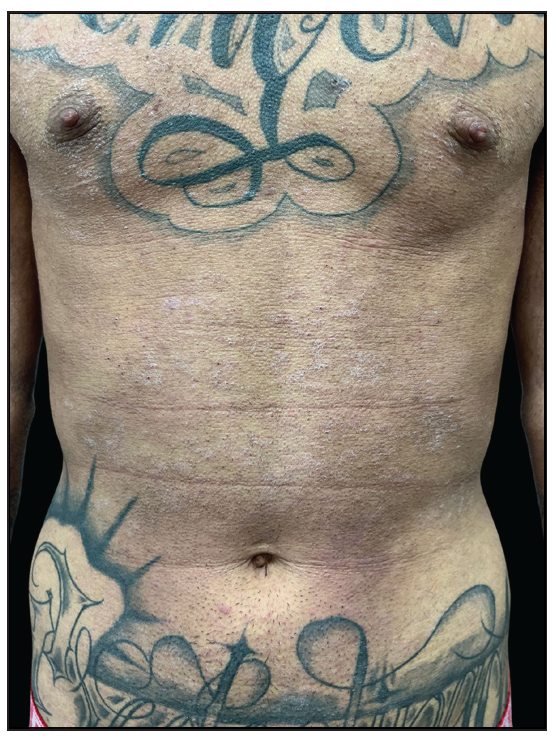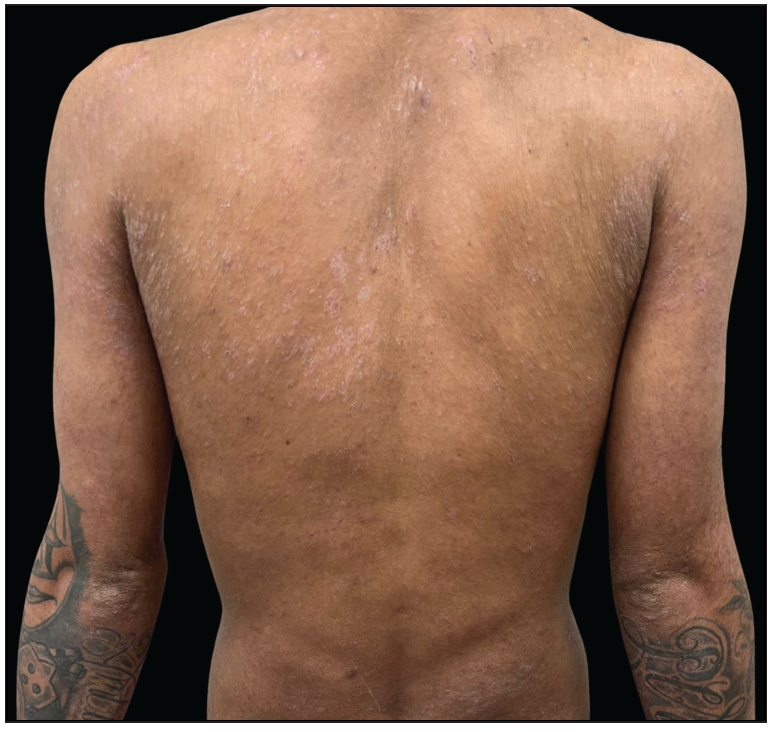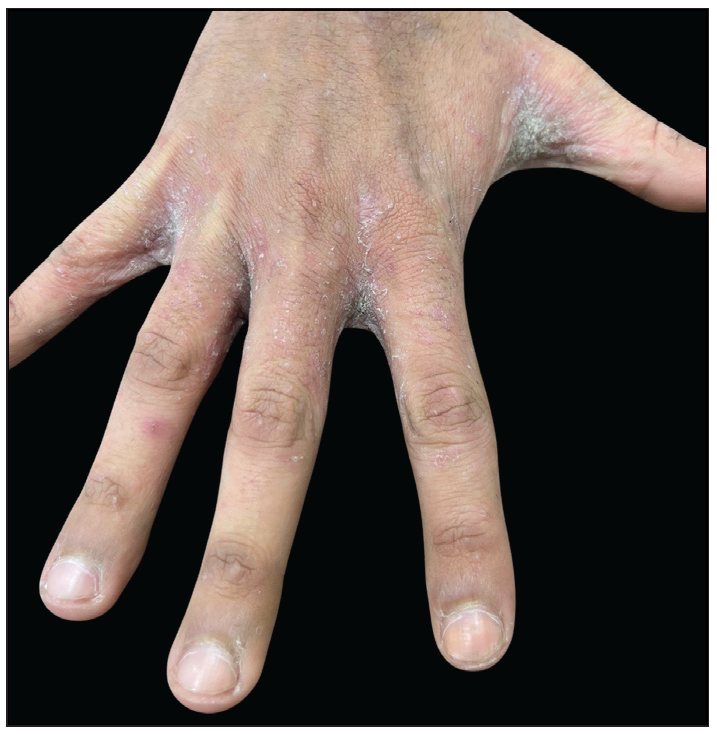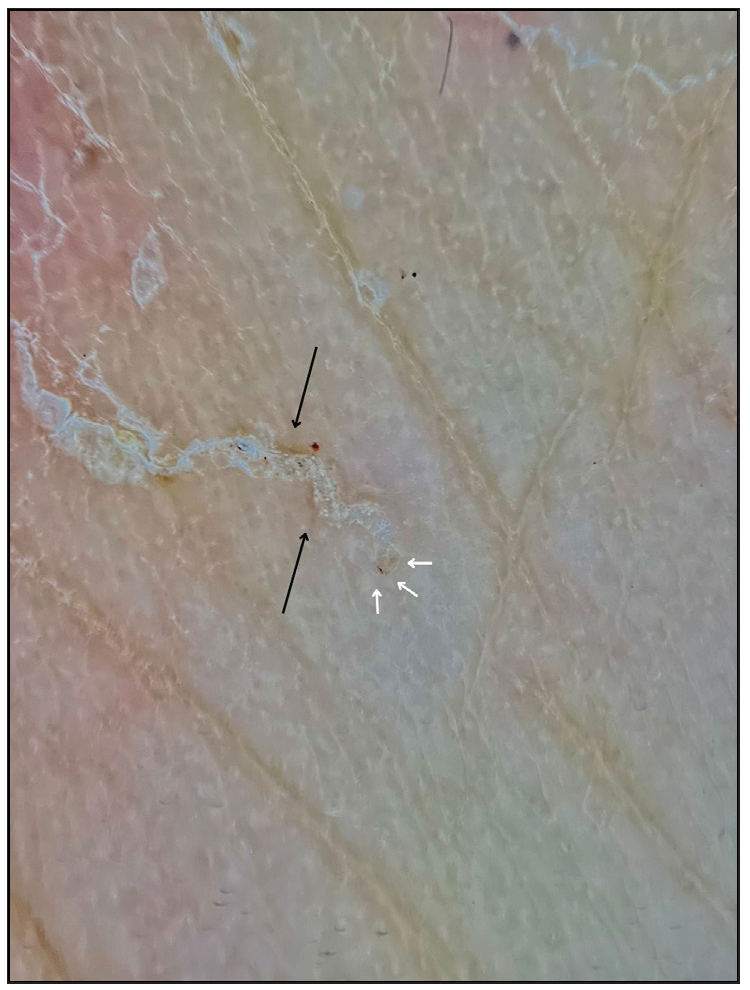Dear Editor,
Crusted scabies is a rare and highly contagious form of disease caused by Sarcoptes scabiei var. hominis. In most cases, it affects immunocompromised patients or institutionalised elderly individuals.1 There are few reports showing a connection between immunobiological therapy and the onset of this presentation2,3, as well as the potential for masking the initial symptoms of scabies, leading to the diagnosis of other dermatoses. We present a case of crusted scabies in a patient being treated with dupilumab for severe atopic dermatitis (AD).
Our patient is a 24-year-old man with severe AD since the age of 15. He had a history of prolonged therapy with topical corticosteroids and moisturisers. Dermatological management with our group began in 2021, involving standard non-pharmacological treatment, oral methotrexate (discontinued due to nausea), and subcutaneous methotrexate (up to 25 mg/week), resulting in partial improvement (SCORAD 70) after 1 year. Dupilumab was initiated in May 2021 (600 mg initially, then 300 mg every 14 days) with significant improvement (SCORAD 20). However, by May 2023, the itching worsened significantly without changes in treatment or new triggers.
Patient developed crusted papular lesions in the armpits, chest, wrists and interdigital region of the hands [Figure 1a, 1b, 1c]. Dermoscopy of the palmar region showed a scabies/diplopoda-like tunnel, along with dark mite spots [Figure 2]. According to treatment guidelines for scabies, a generalist doctor prescribed oral ivermectin at a dose of 15 mg along with 5% topical permethrin in an alcoholic vehicle, but the patient did not tolerate the vehicle.

Export to PPT

Export to PPT

Export to PPT

Export to PPT
The contacting family members developed milder symptoms a few weeks after the onset of his lesions and were treated with oral ivermectin according to their weight and topical 5% permethrin, resulting in complete improvement. The patient, however, continued to experience progression of the characteristic lesions of crusted scabies. A new worsening occurred after 30 days of treatment. That is when he sought consultation with our group. At this point, dupilumab was discontinued.
Given the patient’s inadequate response to standard treatment, a higher-dose regimen was initiated, considering that higher doses are safe in healthy patients.4 Oral ivermectin 15 mg weekly in four doses was prescribed. After four weeks, there was partial improvement of the lesions, and topical permethrin in a cream base was prescribed. The patient underwent three cycles of three nightly applications of 5% permethrin with a 1-week interval between applications. The lesions improved and dupilumab was restarted in August 2023.
AD is a chronic inflammatory disorder marked by pruritus, recurrent eczematous lesions, skin barrier disruption, and immune dysregulation which increases the risk of cutaneous infections.4 Furthermore, immunomodulators (anti-TNF, anti-IL 23, anti-IL 17, and JAK inhibitors) used in the treatment of immune-mediated diseases also increase the risk of these infections. Dupilumab is a human monoclonal antibody that binds to the alpha subunit of the IL-4 receptor, thus blocking both IL-4 and IL-13, both involved in the pathogenesis of AD.2 Its use is associated with significantly improved symptoms – lesions, pruritus, pain and sleep disturbances – while demonstrating a lower incidence of non-herpetic skin infections compared to other immunomodulatory treatments.5
Although rare, serious skin infections have been reported in AD patients on dupilumab treatment, similar to our case.3,6 Rodriguez-Lago documented a case of crusted scabies in an AD patient being treated with dupilumab. Treatment involved ivermectin (14 mg on days 1, 2, 8, 9 and 15), 5% permethrin and 5% salicylic acid cream, leading to a favorable outcome. Due to limited evidence, the role of dupilumab as a risk factor for such infections remains unclear.
Recently, researchers have questioned the development of resistance in S. scabiei to both topical permethrin and oral ivermectin.4 Although there is still no clear evidence regarding the mechanism, the possibility should be considered in cases that are difficult to treat. Our patient was prescribed ivermectin at a dose of 15 mg per week for 4 consecutive weeks, due to the possibility of resistance to ivermectin. Topical permethrin was not used initially due to the patient’s intolerance. With treatment, the patient achieved significant improvement.
In the last few years there has been an increasing use of immunomodulators, particularly dupilumab, for the treatment of AD. We present this case to emphasize the need for vigilance in patients with AD undergoing dupilumab treatment who experience a sudden exacerbation of pruritus or lesions. This may indicate the presence of an associated infestation, like crusted scabies.
留言 (0)